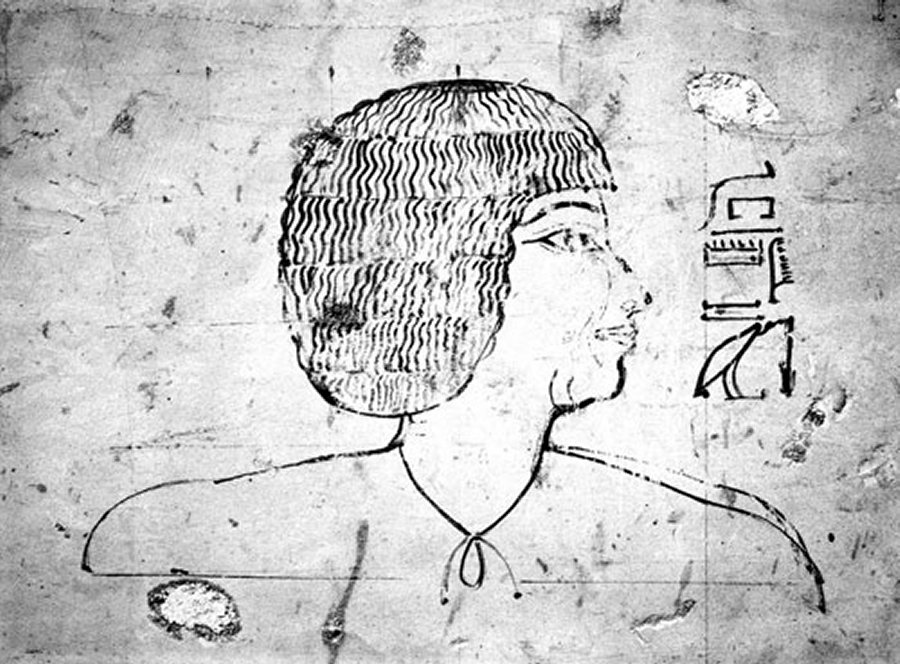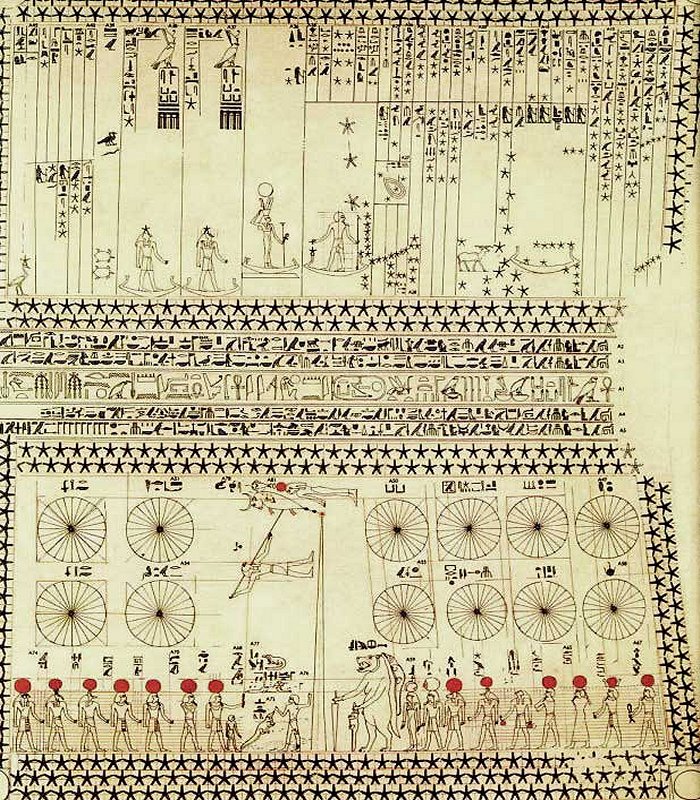Tomb Of Senenmut And Earliest Known Star Map In Ancient Egypt
A. Sutherland - AncientPages.com - The earliest known star map in Egypt was discovered more than eighty years ago and represented the central part of the tomb's decoration; inside the grave, a sketch of the tomb's owner was also found, later identified as Senenmut (Senemut).
Portrait of Senenmut, steward of Amun, in his Deir el-Bahri tomb (TT 252). Photograph by Harry Burton, 1926–27 (M8C 173). Archives of the Egyptian Expedition, Department of Egyptian Art. Credits: The Metropolitan Museum of Art
Senenmut was the steward of Amun, Senenmut, one of the most influential courtiers in the reign of the female pharaoh Hatshepsut and, in fact, her favored courtier.
The tomb (TT 353) is located north of the causeway leading to Hatshepsut's temple at Deir el-Bahri at Thebes on the West bank of the Nile. It was built during the 18th Egyptian dynasty (ca. 1473 BC).
The astronomical ceiling in Senenmut's tomb remains an imposing decoration, divided into two sky panels: southern (depicts decanal stars (small constellations), was often used in ancient Egyptian astronomy. There are also constellations such as Orion and Canis Major.
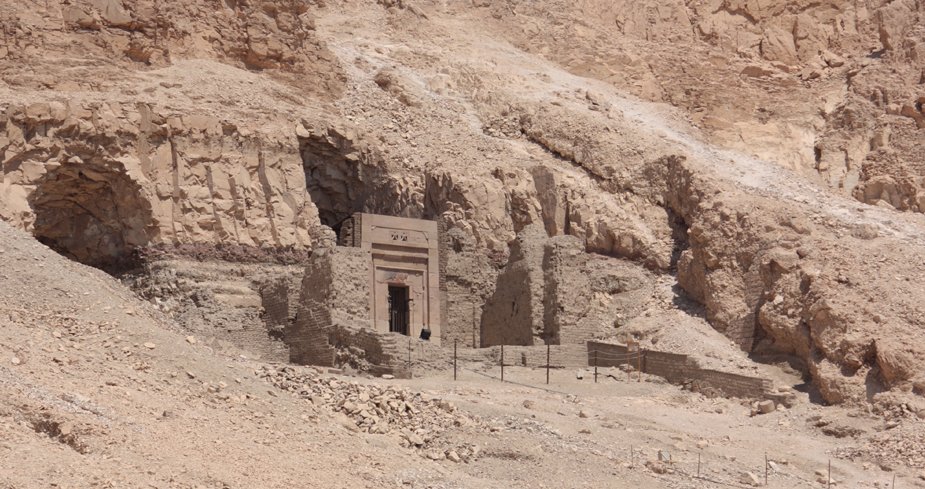 TT 353 of Sen-en-Mut (Senenmut tomb) - a hypogeum built by the order of Sen-en-Mut, 97.36m long and 41.93m deep. Image credit: Edal Anton Lefterov - CC BY-SA 3.0
TT 353 of Sen-en-Mut (Senenmut tomb) - a hypogeum built by the order of Sen-en-Mut, 97.36m long and 41.93m deep. Image credit: Edal Anton Lefterov - CC BY-SA 3.0
Over the sky, planets Jupiter, Saturn, Mercury, and Venus are all related to them, sailing in small boats across the sky. The southern part of the ceiling – means the hours of the night.
The northern part (lower part) shows Ursa Major's constellation; the other constellations remain unidentified. On the right and left of it, there are 8 or 4 circles, and below them are several deities, each carrying a sun disk towards the center of the picture.
The inscriptions associated with the circles mark the original monthly celebrations in the lunar calendar, whereas the deities mark the initial days of the lunar month.
Besides the astronomical ceiling in his tomb at Qurna, excavations also revealed 150 ostraca, including drawings, various lists, reports, and calculations.
The astronomical chart on the ceiling from Senenmut's tomb. Creator of the image: : Charles K. Wilkinson - CC0
The history of Senenmut's tomb is relatively obscure. Until the 16th year of Hatshepsut/Thutmosis III's reign, Senenmut still held his offices; then, something happened. His tracks were lost, and his unfinished tomb (TT353) was closed and partially destroyed.
Did he fall out of favor, or perhaps he retired? Maybe he died from natural causes.
His real burial place is unknown. The fascinating ceiling decoration makes us wonder what kind of person Senenmut was. He was born to literate, provincial-class parents, Ramose and Hatnofer. Yet, he rose to prominence during Hatshepsut's regency and became the king's influential and highly respected vizier.
Ostracon found from the dump below Senenmut's tomb chapel (SAE 71) thought to depict his double profile. Now residing in the Metropolitan Museum.
It is believed that Senenmut had more than 80 different titles.
He entered his career as the "Steward of the God's Wife" (Hatshepsut) and "Steward of the King's Daughter" (Neferure), which was confirmed when archaeologists found a statue carved into a deep niche above the façade of Senenmut's offering chapel.
The figure depicted Senenmut with Hatshepsut's daughter Neferure, whom he served as a tutor.
Was Senenmut also an astronomer? What kind of relationship did he have with Queen Hatshepsut? He was in charge of her money, buildings, and campaigns. His access to her was closer than any other person. In more than 20 statues, he is shown hugging Hatshepsut's daughter as a young child.
But just because they were close doesn't mean they had a sexual relationship.
Written by – A. Sutherland AncientPages.com Staff Writer
updated on June 14, 2022
Copyright © AncientPages.com All rights reserved. This material may not be published, broadcast, rewritten or redistributed in whole or part without the express written permission of AncientPages.com
Expand for referencesReferences:
More From Ancient Pages
-
 Forseti: Norse God Of Justice And Lawmaker Who Lived In A Shining House
Featured Stories | May 1, 2016
Forseti: Norse God Of Justice And Lawmaker Who Lived In A Shining House
Featured Stories | May 1, 2016 -
 Iktomi – Native American Spider-Trickster Spirit Whose Stories Teach Moral Values
Featured Stories | Jan 28, 2019
Iktomi – Native American Spider-Trickster Spirit Whose Stories Teach Moral Values
Featured Stories | Jan 28, 2019 -
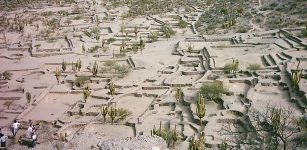 Ancient Ruins Of Quilmes: Largest Pre-Colombian Settlement In Argentina
Featured Stories | Mar 28, 2019
Ancient Ruins Of Quilmes: Largest Pre-Colombian Settlement In Argentina
Featured Stories | Mar 28, 2019 -
 Legend Of Gyanganj – Antediluvian City Of Immortal Sages That Can Only Be Found By The Chosen Ones
Featured Stories | Jul 29, 2017
Legend Of Gyanganj – Antediluvian City Of Immortal Sages That Can Only Be Found By The Chosen Ones
Featured Stories | Jul 29, 2017 -
 Ancient DNA Solves The Mystery Of Mitochondrial Eve And Human Evolution?
Archaeology | Sep 21, 2022
Ancient DNA Solves The Mystery Of Mitochondrial Eve And Human Evolution?
Archaeology | Sep 21, 2022 -
 Tree Rings On the Oregon Coast Show Evidence A Tsunami That Struck The Pacific Northwest In 1700
Archaeology | Sep 3, 2021
Tree Rings On the Oregon Coast Show Evidence A Tsunami That Struck The Pacific Northwest In 1700
Archaeology | Sep 3, 2021 -
 Mount’s Bay, Lyonesse, Langarroc: Legendary Submerged Lands And Buried Towns Of Cornwall
Featured Stories | Apr 21, 2022
Mount’s Bay, Lyonesse, Langarroc: Legendary Submerged Lands And Buried Towns Of Cornwall
Featured Stories | Apr 21, 2022 -
 Why Was The Magical Sword Azoth Of Paracelsus So Special?
Featured Stories | Dec 24, 2020
Why Was The Magical Sword Azoth Of Paracelsus So Special?
Featured Stories | Dec 24, 2020 -
 4000-Year-Old Egyptian Leather Manuscript Forgotten For More Than 70 Years – Found
News | Sep 14, 2015
4000-Year-Old Egyptian Leather Manuscript Forgotten For More Than 70 Years – Found
News | Sep 14, 2015 -
 Mysterious Old Ship With No Crew Reaches The Canadian Coast
Featured Stories | Jul 25, 2024
Mysterious Old Ship With No Crew Reaches The Canadian Coast
Featured Stories | Jul 25, 2024 -
 Miraculous Cauldrons Of The Ancient Celtic World
Myths & Legends | Apr 17, 2024
Miraculous Cauldrons Of The Ancient Celtic World
Myths & Legends | Apr 17, 2024 -
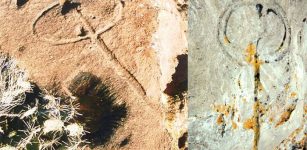 Puzzling Water Glyphs Of The American Southwest – Ancient Astronomical Symbols, Directional Signs Or Something Else?
Featured Stories | Apr 15, 2023
Puzzling Water Glyphs Of The American Southwest – Ancient Astronomical Symbols, Directional Signs Or Something Else?
Featured Stories | Apr 15, 2023 -
 Secrets Of A Lake That Could Re-Write Ancient History Of America – Myths And Gods Reveal A Complex Story – Part 1
Ancient Mysteries | Jun 4, 2018
Secrets Of A Lake That Could Re-Write Ancient History Of America – Myths And Gods Reveal A Complex Story – Part 1
Ancient Mysteries | Jun 4, 2018 -
 Hidden Inca Water System Beneath The Machu Picchu Jungle Discovered By LIDAR
Archaeology | Mar 11, 2022
Hidden Inca Water System Beneath The Machu Picchu Jungle Discovered By LIDAR
Archaeology | Mar 11, 2022 -
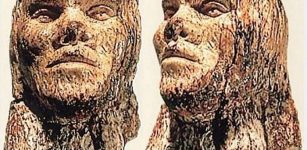 Incredible Mammoth Ivory Male Head From Dolni Vestonice, Czech Dated To 26,000 BC
Artifacts | Jun 23, 2015
Incredible Mammoth Ivory Male Head From Dolni Vestonice, Czech Dated To 26,000 BC
Artifacts | Jun 23, 2015 -
 Ancient Maya People Used Volcanic Ash To Build Pyramids When Huge Eruption Occurred
Archaeology | Sep 22, 2021
Ancient Maya People Used Volcanic Ash To Build Pyramids When Huge Eruption Occurred
Archaeology | Sep 22, 2021 -
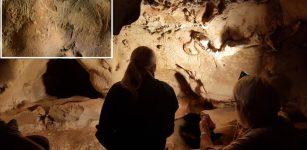 Neanderthal Cave Engravings Identified As Oldest Known, More Than 57,000 Years Old
Archaeology | Jun 22, 2023
Neanderthal Cave Engravings Identified As Oldest Known, More Than 57,000 Years Old
Archaeology | Jun 22, 2023 -
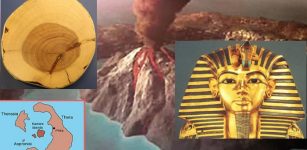 Radiocarbon Dating Method Needs Adjustments – Researchers Say
Archaeology | Apr 1, 2020
Radiocarbon Dating Method Needs Adjustments – Researchers Say
Archaeology | Apr 1, 2020 -
 Men Are Slowly Losing Their Y Chromosome – Is The Future Of Humanity In Danger?
Featured Stories | Nov 7, 2023
Men Are Slowly Losing Their Y Chromosome – Is The Future Of Humanity In Danger?
Featured Stories | Nov 7, 2023 -
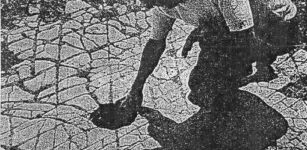 Oklahoma’s Ancient Mosaic Floor With Mysterious ‘Post Holes’ Could Re-Write History Of North America
Civilizations | Aug 10, 2018
Oklahoma’s Ancient Mosaic Floor With Mysterious ‘Post Holes’ Could Re-Write History Of North America
Civilizations | Aug 10, 2018

